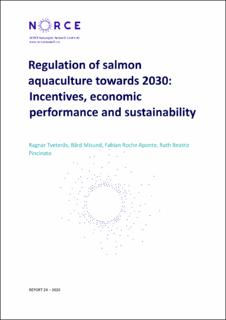| dc.contributor.author | Tveterås, Ragnar | |
| dc.contributor.author | Misund, Bård | |
| dc.contributor.author | Roche Aponte, Fabian | |
| dc.contributor.author | Pincinato, Ruth Beatriz | |
| dc.date.accessioned | 2021-10-19T06:33:43Z | |
| dc.date.available | 2021-10-19T06:33:43Z | |
| dc.date.created | 2021-02-01T00:06:10Z | |
| dc.date.issued | 2020 | |
| dc.identifier.isbn | 978-82-8408-118-2 | |
| dc.identifier.uri | https://hdl.handle.net/11250/2823766 | |
| dc.description.abstract | This report discusses how the future regulation of salmon aquaculture can be designed to provide appropriate incentives for producers to innovate and operate such that the Norwegian society achieve sustainable and economic efficient outcomes. The report recognizes that salmon aquaculture production can lead to negative externalities to its marine environment in the form of emissions, parasites and diseases, and also to habitats in other parts of the world if feed resource use is not properly regulated and contributes to degradation of natural resources. However, for a given production quantity of farmed fish the level of negative externalities can be very different, depending on production technology and practices. | |
| dc.language.iso | eng | |
| dc.publisher | NORCE Norwegian Research Centre AS | |
| dc.title | Regulation of salmon aquaculture towards 2030: Incentives, economic performance and sustainability | |
| dc.type | Research report | |
| dc.description.version | publishedVersion | |
| cristin.ispublished | true | |
| cristin.fulltext | original | |
| dc.identifier.cristin | 1884631 | |
| dc.source.pagenumber | 82 | |
| dc.relation.project | Fiskeri- og havbruksnæringens forskningsfinansiering: 901391 | |
